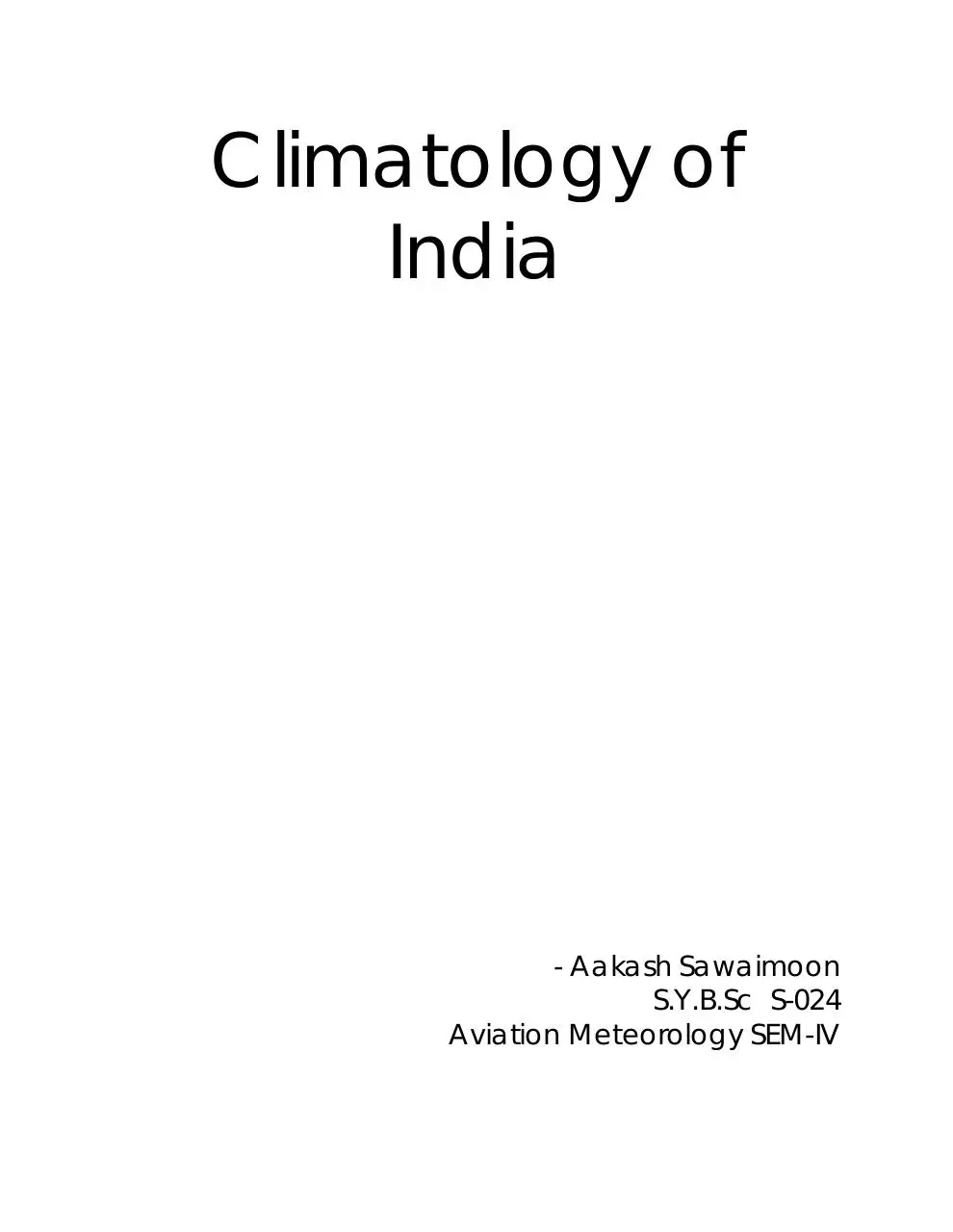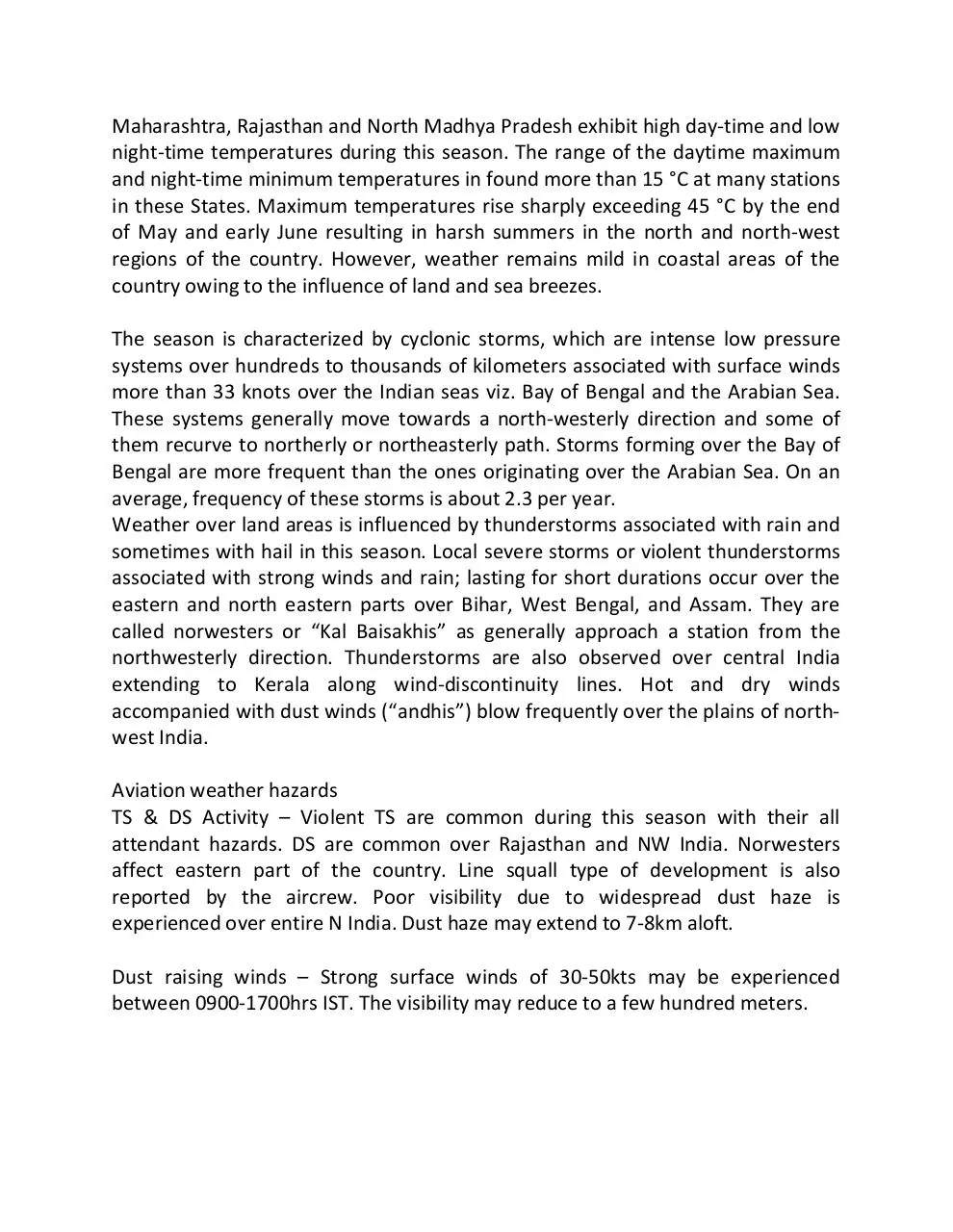Climatology of India (PDF)
File information
Author: BRIEFINGROOM
This PDF 1.5 document has been generated by Acrobat PDFMaker 9.0 for Word / Adobe PDF Library 9.0, and has been sent on pdf-archive.com on 12/12/2015 at 13:15, from IP address 43.251.x.x.
The current document download page has been viewed 1309 times.
File size: 90.48 KB (8 pages).
Privacy: public file





File preview
Climatology of
India
- Aakash Sawaimoon
S.Y.B.Sc S-024
Aviation Meteorology SEM-IV
India is a big tropical country and is famous for its diverse climatic features. India
climate can be categorized into six principal subcategories and this has been
determined by the Koppen climate classification.
The seasons in India can be broadly categorized into the following:
Name of the season
Tenure
Winter
The months of January and February
Summer
The months of March to May
Monsoon (rainy) season
The months of June to September
A post-monsoon period
The months of October to December
India is home to an extraordinary variety of climatic regions, ranging from tropical
in the south to temperate and alpine in the Himalayan north, where elevated
regions receive sustained winter snowfall. The nation's climate is strongly
influenced by the Himalayas and the Thar Desert. The Himalayas act as a barrier
to the frigid katabatic winds flowing down from Central Asia keeping the bulk of
the Indian subcontinent warmer than most locations at similar latitudes. As such,
land areas in the north of the country have a continental climate with severe
summer conditions that alternates with cold winters when temperatures plunge
to freezing point. In contrast are the coastal regions of the country, where the
warmth is unvarying and the rains are frequent.
The country is influenced by two seasons of rains, accompanied by seasonal
reversal of winds from January to July. During the winters, dry and cold air
blowing from the northerly latitudes from a north-easterly direction prevails over
the Indian region. Consequent to the intense heat of the summer months, the
northern Indian landmass becomes hot and draws moist winds over the oceans
causing a reversal of the winds over the region which is called the summer or the
south-west monsoon. This is most important feature controlling the Indian
climate because about 75% of the annual rainfall is received during a short span
of four months (June to September). Variability in the onset, withdrawal and
quantum of rainfall during the monsoon season has profound impacts on water
resources, power generation, agriculture, economics and ecosystems in the
country. The variation in climate is perhaps greater than any other area of similar
size in the world. There is a large variation in the amounts of rainfall received at
different locations. The average annual rainfall is less than 13 cm over the
western Rajasthan, while at Mausiram in the Meghalaya has as much as 1141 cm.
The rainfall pattern roughly reflects the different climate regimes of the country,
which vary from humid in the northeast (about 180 days rainfall in a year), to arid
in Rajasthan (20 days rainfall in a year). So significant is the monsoon season to
the Indian climate, that the remaining season are often referred relative to the
monsoon.
The rainfall over India has large spatial as well as temporal variability. A
homogeneous data series has been constructed for the period 1901-2003 based
on the uniform network of 1476 stations and analyzed the variability and trends
of rainfall. Normal rainfall (in cm) pattern of the country for the four seasons and
annual are depicted in Fig 1 and Fig 2 respectively. Normal monsoon rainfall more
than 150cm is being observed over most parts of northeast India, Konkan & Goa.
Normal monsoon rainfall is more than 400cm over major parts of Meghalaya.
Annual rainfall is more than 200 cm over these regions.
For the country as whole, mean monthly rainfall during July (286.5 mm) is highest
and contributes about 24.2% of annual rainfall (1182.8 mm). The mean rainfall
during August is slightly lower and contributes about 21.2% of annual rainfall.
June and September rainfall are almost similar and contribute 13.8% and 14.2% of
annual rainfall, respectively. The mean south-west monsoon (June, July, August &
September) rainfall (877.2 mm) contributes 74.2% of annual rainfall (1182.8 mm).
Contribution of pre-monsoon (March, April & May) rainfall and post-monsoon
(October, November & December) rainfall in annual rainfall is mostly the same
(11%). Coefficient of variation is higher during the months of November,
December, January and February. India is characterized by strong temperature
variations in different seasons ranging from mean temperature of about 10°C in
winter to about 32 °C in summer season. Details of weather along with associated
systems during different seasons are presented as under:
Winter Season / Cold Weather Season (January and February)
India Meteorological Department (IMD) has categorized the months of January
and February in winter season. However, December can be included in this
season for north-western parts of the country. This season starts in early
December associated with clear skies, fine weather, light northerly winds, low
humidity and temperatures, and large daytime variations of temperature. The
cold air mass extending from the Siberian region has profound influence on the
Indian subcontinent (at least all of the north and most of central India) during
these months.
The mean air temperatures increase from north to south up to 17°N, the decrease
being sharp as one moves northwards in the north-western parts of the country.
The mean temperatures vary from 14 °C to 27°C during January. The mean daily
minimum temperatures range from 22 °C in the extreme south, to 10 °C in the
northern plains and 6 °C in Punjab. The rains during this season generally occur
over the western Himalayas, the extreme north-eastern parts, Tamil Nadu and
Kerala. Western disturbances and associated trough in westerlies are main rain
bearing system in northern and eastern parts of the country.
Aviation weather hazards
Poor visibility is the main aviation hazard during the season, especially over N
India. Fog, mist & haze are common all over the country in the morning and
evening hours. Smoke from industries and automobiles causes reduction in
visibility. Low level inversion further favours reduction in visibility. Conditions
become most favourable for radiation fog after the passage of a WD, over NW
India, Uttar Pradesh, Bihar, Central India, N Bengal and Assam (particularly S
banks of Brahmaputra river). Sometimes the fog prolongs, disrupting air traffic
adversely, especially over polluted airfields like Palam (Delhi) On Such occasions,
there may be little improvement in visibility to 1000-2000m during noon, but it
may again deteriorate in the evening and night. Such conditions sometimes may
last for a few days. Advection fog occurs over costal areas and where large water
bodies are present. The fog generally lifts by 1000-1100 hr IST.
CAT is experienced over NE India and in the vicinity of STJ. Mountain waves are
also common during this period over high terrain over N & E India. Icing – During
the season the freezing level lowers. Hence ice accretion may be experienced at
lower levels.
Pre-monsoon season/ summer season/ Hot weather season/ Thunderstorm
season (March, April and May)
The temperatures start to increase all over the country in March and by April, the
interior parts of the peninsula record mean daily temperatures of 30-35 °C.
Central Indian land mass becomes hot with daytime maximum temperatures
reaching about 40°C at many locations. Many stations in Gujarat, North
Maharashtra, Rajasthan and North Madhya Pradesh exhibit high day-time and low
night-time temperatures during this season. The range of the daytime maximum
and night-time minimum temperatures in found more than 15 °C at many stations
in these States. Maximum temperatures rise sharply exceeding 45 °C by the end
of May and early June resulting in harsh summers in the north and north-west
regions of the country. However, weather remains mild in coastal areas of the
country owing to the influence of land and sea breezes.
The season is characterized by cyclonic storms, which are intense low pressure
systems over hundreds to thousands of kilometers associated with surface winds
more than 33 knots over the Indian seas viz. Bay of Bengal and the Arabian Sea.
These systems generally move towards a north-westerly direction and some of
them recurve to northerly or northeasterly path. Storms forming over the Bay of
Bengal are more frequent than the ones originating over the Arabian Sea. On an
average, frequency of these storms is about 2.3 per year.
Weather over land areas is influenced by thunderstorms associated with rain and
sometimes with hail in this season. Local severe storms or violent thunderstorms
associated with strong winds and rain; lasting for short durations occur over the
eastern and north eastern parts over Bihar, West Bengal, and Assam. They are
called norwesters or “Kal Baisakhis” as generally approach a station from the
northwesterly direction. Thunderstorms are also observed over central India
extending to Kerala along wind-discontinuity lines. Hot and dry winds
accompanied with dust winds (“andhis”) blow frequently over the plains of northwest India.
Aviation weather hazards
TS & DS Activity – Violent TS are common during this season with their all
attendant hazards. DS are common over Rajasthan and NW India. Norwesters
affect eastern part of the country. Line squall type of development is also
reported by the aircrew. Poor visibility due to widespread dust haze is
experienced over entire N India. Dust haze may extend to 7-8km aloft.
Dust raising winds – Strong surface winds of 30-50kts may be experienced
between 0900-1700hrs IST. The visibility may reduce to a few hundred meters.
This is the most hazardous season for flying. The main aviation weather hazards
are TS/TD, Dust Haze, Squall, High temperatures, Dust Raising Winds, Norwesters,
Andhi etc.
South-west Monsoon/ Summer Monsoon (June, July, August and September)
The SW monsoon is the most significant feature of the Indian climate. The season
is spread over four months, but the actual period at a particular place depends on
onset and withdrawal dates. It varies from less than 75 days over West Rajasthan,
to more than 120 days over the south-western regions of the country contributing
to about 75% of the annual rainfall.
The onset of the SW monsoon normally starts over the Kerala coast, the southern
tip of the country by 1 June, advances along the Konkan coast in early June and
covers the whole country by middle of July. However, onset occurs about a week
earlier over islands in the Bay of Bengal. The monsoon is a special phenomenon
exhibiting regularity in onset and distribution within the country, but inter-annual
and inter-annual variations are observed. The monsoon is influenced by global
and local phenomenon like El Nino, northern hemispheric temperatures, sea
surface temperatures, snow cover etc. The monsoonal rainfall oscillates between
active spells associated with widespread rains over most parts of the country and
breaks with little rainfall activity over the plains and heavy rains across the
foothills of the Himalayas. Heavy rainfall in the mountainous catchments under
‘break’ conditions results flooding over the plains. However, very uncomfortable
weather due to high humidity and temperatures is the feature associated with the
breaks.
Cyclonic systems of low pressure called ‘monsoon depressions’ are formed in the
Bay of Bengal during this season. These systems generally form in the northern
part of the Bay with an average frequency of about two to three per month and
move in a northward or north-westward direction, bringing well-distributed
rainfall over the central and northern parts of the country. The distribution of
rainfall over northern and central India depends on the path followed by these
depressions. SW monsoon current becomes feeble and generally starts
withdrawing from Rajasthan by 1st September and from north-western parts of
India by 15th September. It withdraws from almost all parts of the country by
15th October and is replaced by a northerly continental airflow called North-East
Monsoon. The retreating monsoon winds cause occasional showers along the east
coast of Tamil Nadu, but rainfall decreases away from coastal regions.
Flying in monsoon clouds is relatively smooth, as they are stratiform type and
visibility is exceptionally good, except in precipitation. Clouds are in different
layers and there are clear gaps in between various layers of clouds. Hence one can
mostly find a suitable cloud free level for flying, except when affected by a
depression.
Post-monsoon or Northeast monsoon or Retreating SW Monsoon season
(October, November and December)
North-East (NE) monsoon or Post-monsoon season is transition season associated
with the establishment of the north-easterly wind regime over the Indian
subcontinent. Meteorological subdivisions namely Coastal Andhra Pradesh
Rayalaseema, Tamil Nadu, Kerala and South Interior Karnataka receive good
amount of rainfall accounting for about 35% of their annual total in these months.
Many parts of Tamil Nadu and some parts of Andhra Pradesh and Karnataka
receive rainfall during this season due to the storms forming in the Bay of Bengal.
Large scale losses to life and property occur due to heavy rainfall, strong winds
and storm surge in the coastal regions. The day temperatures start falling sharply
all over the country. The mean temperatures over north-western parts of the
country show decline from about 38°C in October to 28°C in November. Decrease
in humidity levels and clear skies over most parts of north and central India after
mid-October are characteristics features of this season (NATCOM 2004, IMD
2010).
Maximum cyclonic storms (CS) occur in October over the Bay of Bengal and in
November over the Arabian Sea. Severe cyclonic storms are more in November
than in October. They usually form near Andaman seas and move towards Tamil
Nadu, Andhra and Orissa. The CS normally strike Tamil Nadu coast. Some of them
move north and strike West Bengal or Bangladesh coasts. A few of them after
crossing over the peninsula emerge over the Arabian Sea, revive, recurve and
strike Maharashtra & Gujarat coasts.
Aviation weather hazards
Poor Visibility – Generally visibility is good. However, as the season progresses
visibility starts deteriorating near industrial areas during dawn and dusk. After the
passage of a WD there may be fog or mist. In the South poor visibility is during
precipitation.
Low Clouds – Low clouds, very strong winds, heavy rain and TS activity is
experienced during the passage of a CS.
CAT – Clear Air Turbulence may be experienced due to STJ in the north.
Download Climatology of India
Climatology of India.pdf (PDF, 90.48 KB)
Download PDF
Share this file on social networks
Link to this page
Permanent link
Use the permanent link to the download page to share your document on Facebook, Twitter, LinkedIn, or directly with a contact by e-Mail, Messenger, Whatsapp, Line..
Short link
Use the short link to share your document on Twitter or by text message (SMS)
HTML Code
Copy the following HTML code to share your document on a Website or Blog
QR Code to this page

This file has been shared publicly by a user of PDF Archive.
Document ID: 0000323769.